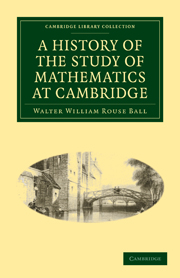Book contents
- Frontmatter
- PREFACE
- Contents
- Chapter I Mediæval mathematics
- Chapter II The mathematics of the renaissance
- Chapter III The commencement of modern mathematics
- Chapter IV The life and works of Newton
- Chapter V The rise of the Newtonian school
- Chapter VI The later Newtonian school
- Chapter VII The analytical school
- Chapter VIII The organization and subjects of education
- Chapter IX The exercises in the schools
- Chapter X The mathematical tripos
- Chapter XI Outlines of the history of the university
- INDEX
Chapter VI - The later Newtonian school
Published online by Cambridge University Press: 07 September 2010
- Frontmatter
- PREFACE
- Contents
- Chapter I Mediæval mathematics
- Chapter II The mathematics of the renaissance
- Chapter III The commencement of modern mathematics
- Chapter IV The life and works of Newton
- Chapter V The rise of the Newtonian school
- Chapter VI The later Newtonian school
- Chapter VII The analytical school
- Chapter VIII The organization and subjects of education
- Chapter IX The exercises in the schools
- Chapter X The mathematical tripos
- Chapter XI Outlines of the history of the university
- INDEX
Summary
I have already explained that the results of the infinitesimal calculus may be expressed in either of two notations. In most modern books both are used, but if we must confine ourselves to one then that adopted by Leibnitz is superior to that used by Newton, and for some applications—such as the calculus of variations—is almost essential. The question as to the relative merits of the two methods was unfortunately mixed up with the question as to whether Leibnitz had discovered the fundamental ideas of the calculus for himself, or whether he had acquired them from Newton's papers, some of which date back to 1666. Personal feelings and even national jealousies were appealed to by both sides. Finally Newton's notation was generally adopted in England, while that invented by Leibnitz was employed by most continental mathematicians. The latter result was largely due to the influence of John Bernoulli, the most famous and successful mathematical teacher of his age, who through his pupils (especially Euler) determined the lines on which mathematics was developed on the continent during the larger part of the eighteenth century.
A common language and facility of intercommunication of ideas are of the utmost importance in science, and even if the Cambridge school had enjoyed the use of a better notation than their continental contemporaries they would have lost a great deal by their isolation. So little however did they realize this truth that they made no serious efforts to keep themselves acquainted with the development of analysis by their neighbours.
- Type
- Chapter
- Information
- A History of the Study of Mathematics at Cambridge , pp. 97 - 116Publisher: Cambridge University PressPrint publication year: 2009First published in: 1889



